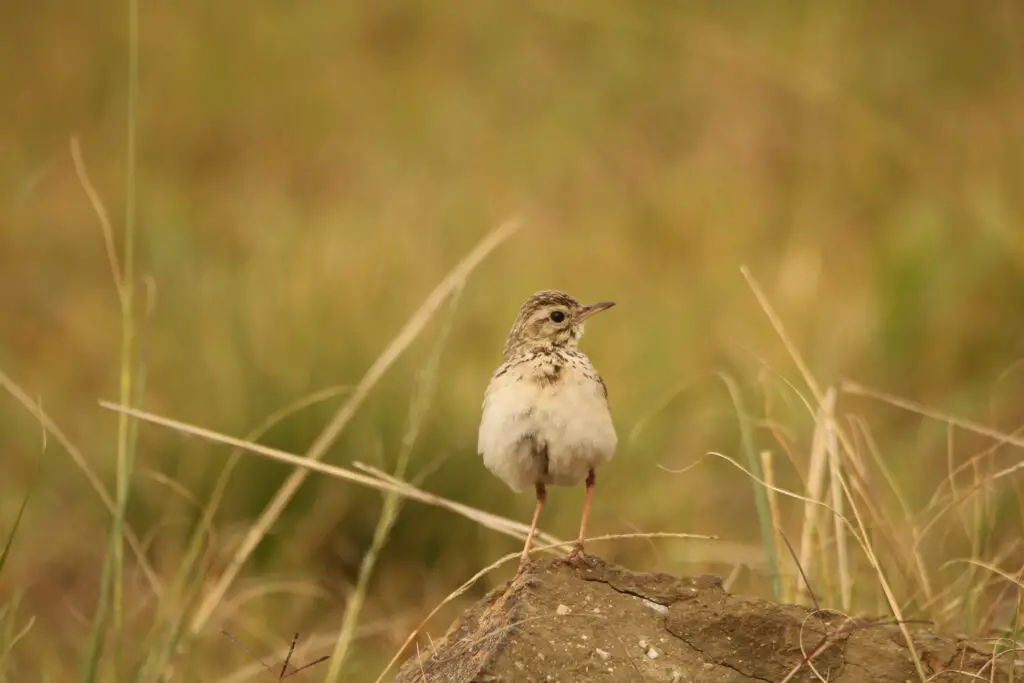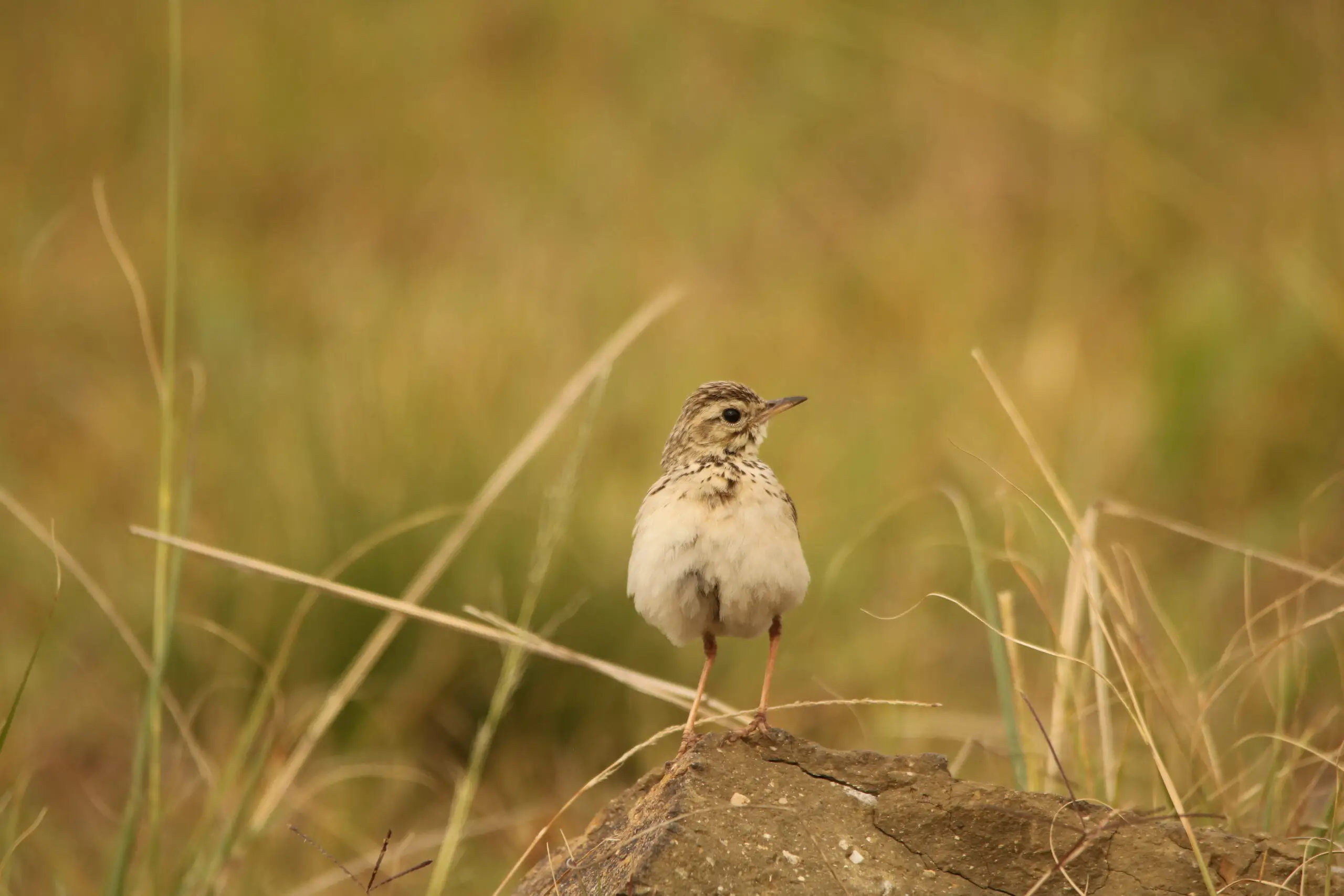The African rock pipit (Anthus crenatus) is a small passerine bird that belongs to the family Motacillidae. It is found in rocky habitats of southern and eastern Africa, ranging from South Africa to Ethiopia.
The species has been classified as ‘Least Concern’ by the International Union for Conservation of Nature (IUCN), indicating that its population size and distribution are stable.
Despite being relatively common across its range, little research has been conducted on the biology and ecology of the African rock pipit. This bird’s cryptic nature makes it challenging to study, as it blends well with its habitat and can be difficult to detect.
However, recent studies have shed some light on various aspects of this species’ life history, including breeding behavior, vocalizations, and genetic diversity.
In this article, we provide an overview of what is currently known about the African rock pipit, highlighting areas where further research is needed to better understand its ecology and conservation status.

Classification And Distribution
The African rock pipit, scientifically known as Anthus crenatus, is a small passerine bird species belonging to the family Motacillidae.
The classification of this species has undergone some revisions due to its close resemblance to other pipits in Africa and Eurasia. However, genetic studies have provided evidence for its separate lineage from the water pipit and tree pipit.
Evolutionary history suggests that the African rock pipit’s ancestors originated in Asia and migrated to Africa about 2 million years ago during the Pliocene epoch.
This bird species is endemic to southern Africa where it inhabits rocky areas, grasslands, and mountainous regions up to an elevation of 4000 meters above sea level. Its range extends from Angola, Zimbabwe, Mozambique, Namibia, South Africa, Lesotho, Swaziland to Botswana.
Population trends indicate that although the African rock pipit is not globally threatened with extinction at present, there are declining numbers of individuals in certain parts of their distribution range due to habitat loss.
In particular, human encroachment on natural habitats through urbanization or agricultural activities poses a significant threat. Conservation efforts need to focus on mitigating these impacts and ensuring sustainable management practices that promote biodiversity conservation for future generations.
Habitat And Behavior
Having discussed the classification and distribution of the African rock pipit in the previous section, we will now delve into its habitat and behavior. This information is crucial for understanding how this bird species adapts to its environment and interacts with other organisms.
One of the key aspects to understand about the African rock pipit’s habitat is its nesting habits. These birds typically build their nests on rocky outcrops or crevices, often near water sources like rivers or streams. The nest is usually made up of dry grasses and plant material, lined with finer materials such as feathers or hair. Interestingly, these birds have been known to reuse old nests from other bird species instead of building a new one from scratch.
In terms of foraging behavior, the African rock pipit primarily feeds on insects but may also consume small seeds and fruits when available. They are active during the day, searching for prey by hopping along rocks or short flights between perches. When they spot an insect, they quickly dart down to grab it with their beak before returning to their perch. Overall, these behaviors allow them to thrive in their rocky habitats despite harsh conditions.
- Did you know that African rock pipits can sing over 100 different songs?
- Despite being found across sub-Saharan Africa, populations are declining due to habitat loss.
- These birds may exhibit territorial behavior during breeding season.
- In some cultures, African rock pipits are believed to bring good luck if seen before important events.
Overall, gaining insight into the nesting and foraging behaviors of the African rock pipit highlights how adaptable this species can be in challenging environments. By continuing research efforts and conservation measures focused on protecting their natural habitats, we can ensure these unique birds continue to thrive in our world.
Breeding Biology
The African rock pipit is a small passerine bird found in rocky areas of southern Africa. Breeding success for this species can vary depending on environmental factors such as rainfall and temperature, with some years showing higher rates of nest failure. However, overall breeding success has been reported to range from 30-60%, indicating that the African rock pipit is able to successfully breed despite challenges.
Nesting behavior for the African rock pipit involves building a cup-shaped nest made of grasses and other plant materials, typically placed on or near rocks. Females are responsible for incubating the eggs while males provide food and protect the territory. The clutch size usually consists of 2-3 eggs, which hatch after approximately two weeks. Chicks fledge around three weeks after hatching, but remain dependent on their parents for up to another month before becoming independent.
Overall, understanding the breeding biology of the African rock pipit provides valuable insight into how this species is able to survive and thrive in its rocky habitat. While there may be challenges such as nest predation and variable breeding success, these birds have adapted through behaviors like parental care and successful fledging. It is important that conservation efforts take into account not only threats to individual birds but also factors affecting their reproduction and survival as a population.
Vocalizations
Breeding Biology of the African Rock Pipit has been well documented in recent years. They breed once a year and their breeding season starts from August to February, peaking around November and December. The male rock pipits are known for their territorial displays during courtship which often involve singing and presenting nesting materials to females. During this time, both sexes participate in nest-building where they construct a platform of grasses, leaves and other vegetation on rocky outcrops.
Vocalizations play an important role in the communication strategies of African Rock Pipits. Male birds produce complex songs that consist of different notes and phrases, with each song lasting for several seconds before transitioning into another one. These songs can be heard at various times throughout the day but are most commonly sung early in the morning or late afternoon when there is less ambient noise.
Female pipits also sing, although their songs are generally simpler than those produced by males. The complexity of the African Rock Pipit’s songs reflects its communication strategy as it helps them attract mates, defend territories and deter predators. Recent research has shown that these songs may also convey information about individual identity, quality or condition, or provide cues about local environmental conditions such as weather patterns or food availability.
Overall, understanding how birds use vocalizations to communicate offers valuable insights into their behavior and ecology.
Genetic Diversity
The African Rock Pipit, a small songbird found in Southern Africa, is an important species to study for understanding the evolutionary history of avian populations.
Genetic diversity plays a crucial role in shaping the evolution of species and their adaptation to changing environments. By analyzing the genetic makeup of different populations of this bird, researchers can gain insights into its population structure and how it has changed over time.
One approach used in studying genetic diversity is through DNA sequencing. This technique allows for the identification of variations within genes that can help determine relationships among individuals and populations.
Analysis of the African Rock Pipit’s mitochondrial DNA revealed significant differences between populations across its range, indicating potential barriers to gene flow that could be contributing to its diverse population structure.
Understanding the genetic diversity and population structure of the African Rock Pipit contributes not only to our knowledge of avian evolution but also has practical implications for conservation efforts.
With increasing threats from habitat loss and climate change, identifying unique genetically distinct populations is vital for prioritizing conservation actions. Further research on this species can provide valuable information towards ensuring its long-term survival.
Conservation Status And Future Research
As discussed in the previous section, genetic diversity plays a crucial role in the survival and adaptability of species. In this section, we will shift our focus to the conservation status and future research of the African Rock Pipit (Anthus crenatus).
The African Rock Pipit is a small passerine bird species that inhabits rocky areas across sub-Saharan Africa. Although not currently listed as globally threatened, there are concerns about its declining populations due to habitat loss, climate change, and human disturbances such as mining activities.
Furthermore, little is known about its biology and ecology, making it challenging to develop effective conservation strategies.
To mitigate threats facing the African Rock Pipit population and conserve their habitats, several strategies have been proposed. One approach involves protecting critical breeding sites from human disturbance through designating them as protected areas or wildlife reserves. Additionally, efforts can be made to restore degraded habitats by planting native vegetation and removing invasive plant species.
Finally, public awareness campaigns on the importance of conserving biodiversity could also help reduce anthropogenic impacts on these birds’ populations.
In conclusion, although more research needs to be conducted on the African Rock Pipit’s biology and ecology before effective conservation strategies can be developed fully; current approaches aim at mitigating existing threats through targeted protection measures for critical breeding sites and habitat restoration initiatives while raising public awareness on biodiversity conservation.
As such, collaborative efforts between governments, non-governmental organizations (NGOs), local communities are essential towards ensuring long-term survival of this beautiful bird species.
Conclusion
The African rock pipit is a small passerine bird that inhabits rocky areas across sub-Saharan Africa. This species belongs to the family Motacillidae and is closely related to other pipit species found worldwide.
The African rock pipit shows considerable genetic diversity, which may reflect adaptation to different environmental conditions. This species exhibits some unique behaviors, such as hovering over rocks or cliffs while singing its song.
Despite being widespread in its distribution, little information exists on the population size and trends of this species. Further research is needed to understand the factors affecting their habitat use and breeding success, particularly given potential threats from habitat loss and climate change.
Conservation efforts should focus on protecting suitable habitats for this fascinating bird species.

